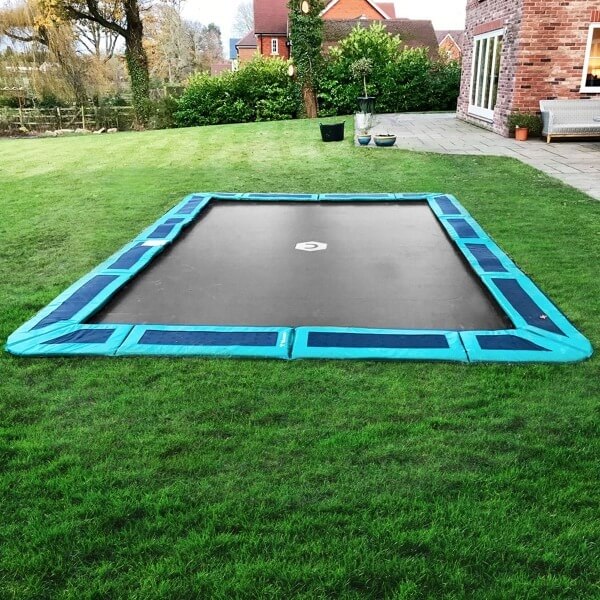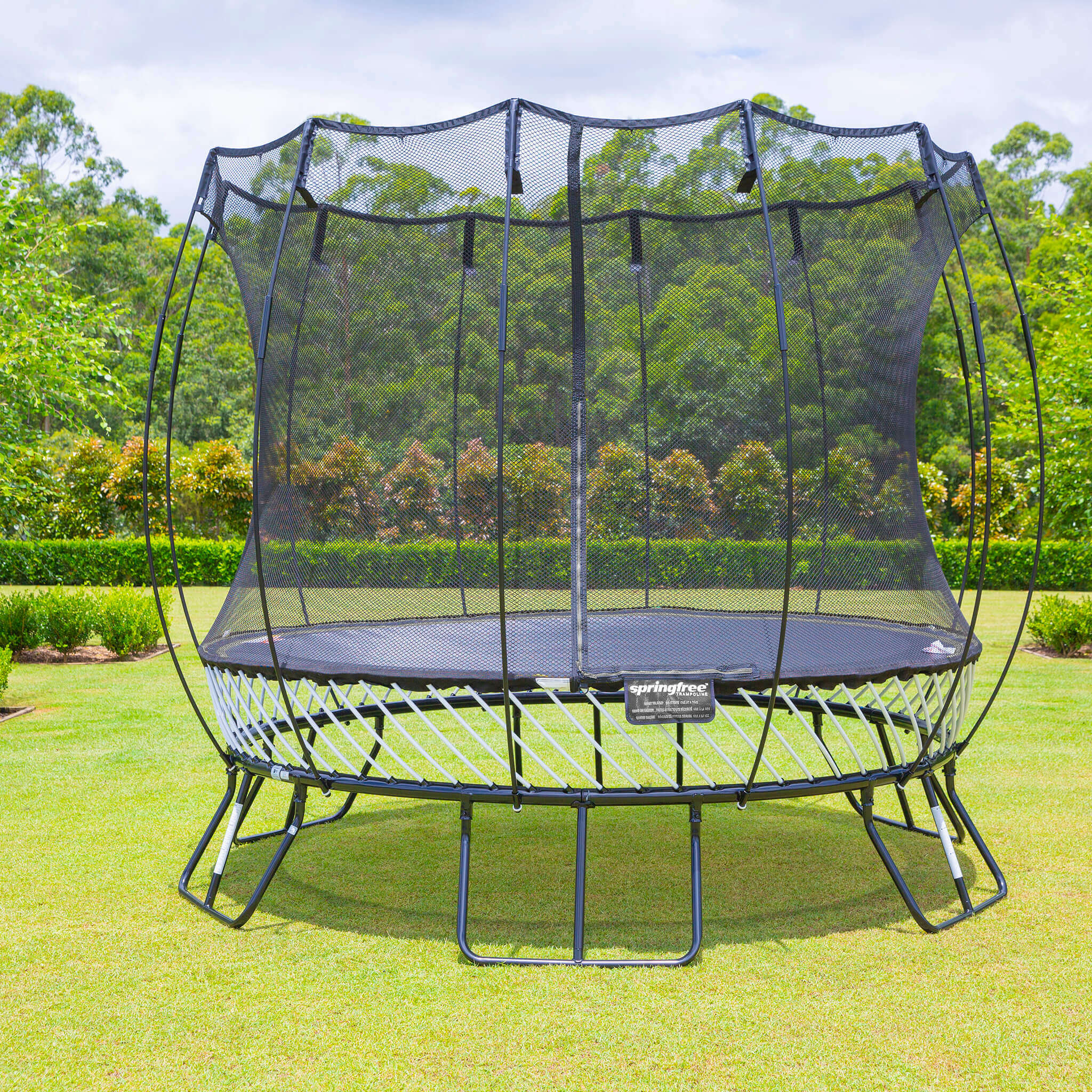How Much Does an Inground Trampoline Cost? (2024)
Thinking about buying an inground trampoline? Find out the cost and other factors involved when making a decision. Get all the answers you need here!
min read

Inground trampolines are a big commitment in time, money and backyard space. The most pertinent for many, though, is the cost.
How much does it cost to put a trampoline into the ground?
That is the question we will use our decades of experience as a trampoline innovator and manufacturer to thoroughly answer for you.
Although we created the springless trampoline, which usually sits above the ground, we have become intimately familiar with the inground trampoline process.
And it is a process. A process for which you need to know the cost of and what it entails before committing so you won’t regret it after it is already installed into the ground.
In this article, we’ll be going over what an inground trampoline is, the cost to install one and the main factors that play into the total price.
After reading this, you will have everything you need to assess if the cost of an inground trampoline is worth it for you and your family.
What Is an Inground Trampoline?
An inground trampoline, simply put, is a trampoline that is installed into the ground—which makes the jumping mat sit flush with the ground. This differs from an above ground trampoline, which, like the name implies, sits above the ground.
There are multiple benefits to installing a trampoline into the ground, including:
-
The elimination of falling injuries—the most common type of trampolining injury.
-
Doesn’t stick out in your yard like above ground trampolines.
-
Less affected by weather—like heavy winds.
-
Accessibility, meaning it’s easy to get on and off the trampoline.
Just as there are benefits to inground trampolines, there are also drawbacks to installing a trampoline in the ground. Some of the cons include:
-
The installation process takes much longer and likely requires professional assistance.
-
It’s meant to be a permanent backyard structure, which means moving it or getting rid of it would also likely require professional assistance.
-
Even though inground trampolines eliminate falling injuries, they still have safety concerns, such as metal springs and a metal frame that can cause injury if fallen on.
-
The cost.
That last factor is the main discussion of today because cost, along with complicated installation, is predominantly why most trampoline owners install their trampoline above the ground and not in the ground.
Example of an inground trampoline (via Yard Illumination):

For reference, here is what an above ground trampoline looks like:

How Much Does an Inground Trampoline Cost?
If you want a general price range to work with, the cost of an inground trampoline can range from $1,500-$5,000 or more.
For reference, an above ground trampoline can range from $100-$4,500 or more. (Check out our article on the cost of a trampoline to learn more about above ground trampoline cost).
While both types of trampolines can be expensive, inground trampolines will almost always have a total value exceeding $1,000.
Why is that the case? Here are the three factors that contribute most to the cost of an inground trampoline:
3 Factors That Go Into the Cost of an Inground Trampoline
-
Size and Quality of the Trampoline
Before even starting the installation, you first need to pick out the type of trampoline you want.
The bigger, better-quality inground trampoline kit will cost more than a basic inground trampoline kit.
For instance, the Avyna Pro Line’s 10 ft x 17 ft Rectangle Inground Trampoline costs $2,795 for just the trampoline (no installation). However, an 12 ft Round Trampoline from Capital Play costs $2,235 without installation.
If you decide to include additional accessories as a part of an inground trampoline bundle, like LED lights and a cover, that will also drive up the price.
-
Professional Installation
While the inground trampoline kit itself will cost you over $1,000, the cost is most felt in the inground trampoline installation process.
Unless you have experience installing trampolines in the ground, you will likely have to hire professionals to complete the installation for you.
The cost of installing an inground trampoline can be pricey. Installation for an inground trampoline can cost up to $3,500 or more depending on a few fundamental factors. Let’s go over each of these factors in more detail:
Depth of the Hole
The first form of assistance you will need to seek is professional excavation to have the hole dug properly and at the appropriate depth.
Excavation can cost anywhere from $400-$1,500, according to HomeServe, and it will largely depend on the size of the hole and how deep you need to dig.
If you were to get a 14 ft round trampoline, you will need a hole that’s about 3 ft deep to accommodate the trampoline, according to GetTrampoline.
Filling in the Hole
This next part of the installation is optional but is recommended to avoid the build-up of vegetation.
Once the hole is dug, you can leave it as packed dirt and move on to the retaining wall (coming up next). However, it’s recommended to fill out the hole with gravel, brick, stones or cement to avoid the unwanted accumulation of flora.
Unless you do this yourself, the cost of the materials and labor will likely be added to the installation cost.
Here’s a look at an inground trampoline installation, courtesy of Trampoline Holes:

Retaining Wall
Another must-have for an inground trampoline is a retaining wall, which can cost around $2,000 (HomeServe). The cost can depend on whether you decide to use wood or concrete to build the retaining wall.
A retaining wall maintains the shape of the trampoline, and unless you have experience, you will likely want to hire a professional landscaper to build the retaining wall and run the drainage pipes.
Water Drainage
Speaking of drainage pipes, you will need to have some type of drainage system in place to make sure water does not accrue in the hole that was dug for the trampoline.
The solution could be a soil drainage system or a sewer system that aligns with the conditions of your home. If it’s intricate enough, the cost of proper drainage can range from a few hundred dollars to several thousand dollars when including the cost of materials and labor.
-
Optional Accessories
The last factor that can contribute to the total cost of an inground trampoline is any optional accessories you want to include.
Some of the accessories you can purchase for an inground trampoline include:
-
Trampoline cover
-
Trampoline frame pads
-
Trampoline enclosure (net)
-
Trampoline basketball hoop (Check out our list of best trampoline basketball hoops!)
-
Trampoline lightening system
Inground trampoline accessories can range from $2-$400 (trampolines.com) or more depending on the type of accessory you choose.
Read our blog on the 9 accessories you can buy for a trampoline to see a detailed list of “extras” that you can purchase to upgrade your trampoline.
Is an Inground Trampoline Right for You?
Suffice it to say, inground trampolines are not an inexpensive purchase.
The cost of the trampoline kit combined with the complexity/cost of the installation process makes having an inground trampoline impractical for most trampoline seekers.
That being said, an inground trampoline does come with some unique advantages that an above ground trampoline cannot replicate.
If the cost and installation process is not prohibitive to you, an inground trampoline might be worth looking at in more detail.
But you likely need more information before casting your vote on which type of trampoline is right for you.
At Springfree Trampoline, we aim to provide you with all the resources and tools necessary to make an informed purchase. Because it’s been proven, time and time again, that informed buyers make better purchasing decisions.
Check out our blog comparing inground trampolines to above ground trampolines to move one step closer to getting the trampoline that will provide your family with endless joyful moments (and minimal headaches) in the future!

